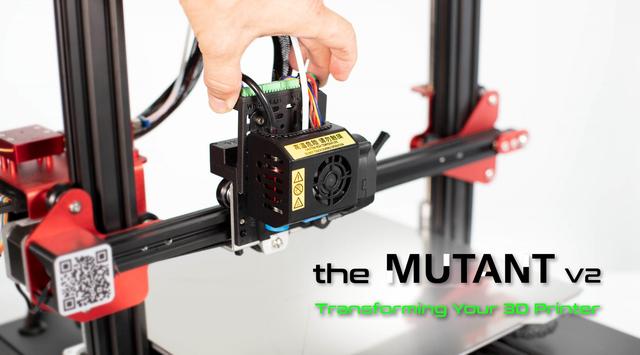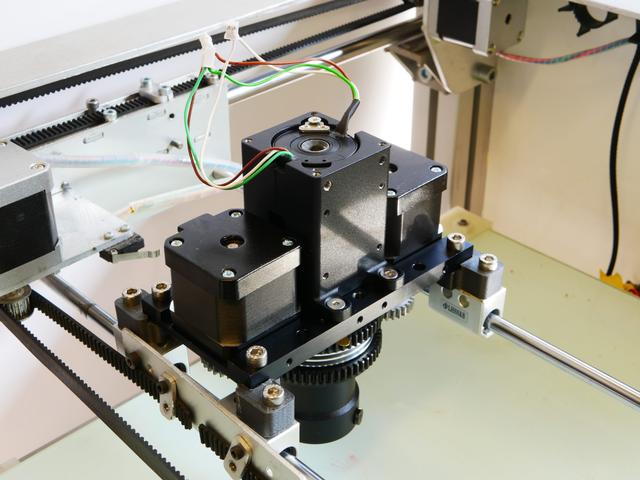
By cuterose
The future of technology: 3D printing experts on the frontier
3D printing experts have given us their forecasts for the additive manufacturing trends to watch and also the future of 3D printing.
Of course, 3D printing does not exist in a vacuum (except when it does). Figuratively speaking, additive manufacturing must be considered in relation to the bigger picture. Whether that is the immediate 3D printing ecosystem of materials, machines, and software or the wider world of technology, economic and social forces.
Therefore, the final question we asked the industry leaders was what non-AM/3DP frontier technology do you see as the most significant for the coming decade and why?
All extruder, no filament?
As noted in earlier articles, there is a tendency to bristle against marketing terminology. However consider how earlier terms such as the Internet or the Cloud proved useful in crystallizing a vision and differentiating such technologies from the earlier physical, and digital, elements they were formed from.
Extending this to today’s buzzwords, will Decentralized Autonomous Organizations, Web3, the Metaverse, or Non-Fungible Tokens advance beyond their initial manifestations?
Alternatively, and to coin a phrase, are some of these technologies all extruder and no filament?
The AI’s have it
The responses reveal an industry optimistic about the future and the role of technology within it. The second most mentioned theme was a concern for the climate and how technology can be harnessed to address net-zero goals for carbon. Within this theme, the experts discuss renewable energy such as hydrogen, energy storage including solid-state batteries and recycling, and electric vehicles.
Also featuring prominently was the use of advanced visualization and collaborative tools, specifically Augmented Reality (AR) and Virtual Reality (VR). How (and if) the Metaverse comes to be manifested for the mainstream user remains to be seen. Will Zuckerberg’s Facebook mutate into Neal Stephenson’s Global Multimedia Protocol Group, or will the currently cumbersome nature continue to deter wider adoption?
Data and the software needed to generate useful information or applications are considered by the experts, whether in manufacturing execution systems, the digital thread, the digital marketplace, or big data. Receiving fewer mentions were distributed ledger technologies and FinTech – here NFT’s, decentralized networks and blockchain-based systems were on the expert’s radar – but of note to fewer respondees. Likewise, while fascinating topics, synthetic biology, and materials received only a couple of mentions.
But the most frequently cited technology, mentioned by a quarter of our experts, was Artificial Intelligence (AI) and Machine Learning (ML).
McKinsey’s most recent State of AI report shows service operations, product and service development, and marketing and sales as the top three areas where AI is currently applied. Our respondents look towards enhanced generative design tools and cloud-based intelligent systems underpinning the future of advanced manufacturing.
What are your thoughts about the most significant frontier technology and the future of 3D printing? Get in touch.
If you enjoy this article why not subscribe to the free 3D Printing Industry newsletter?
Dr. Jeffrey Graves, President & CEO, 3D Systems
We’re seeing machine learning/artificial intelligence playing a more important role in additive manufacturing – powering software that is underlying the entire manufacturing workflow. Not only is machine learning optimizing organizations’ use of 3D printing, but it is also optimizing other advanced manufacturing technologies, including robotic welding, machining, finishing, and inspection operations, in full production environments. While this technology is playing an important role within our industry, I believe it will play a significant role more broadly within society over the coming decade.
We’re already seeing how cloud-based intelligent systems are making our lives easier, and more efficient. If we’re ordering take-out through an app, or a ride via one of the well-known rideshare services, machine learning/AI is already playing a role. We’re also seeing this technology’s influence in healthcare, whereby virtual visits with a physician are removing the need to take time out of our busy schedules to physically drive to a medical office. Instead, we can request a virtual appointment, and through the power of our laptop or smart device, from the comfort of our own homes, both patient and physician can discuss and assess symptoms for the physician to render a diagnosis and prescribe a treatment. Over the coming decade, I think we’ll see the role of machine learning continue on its upward trajectory, influencing in a greater way how we interact with one another and closing the physical gap to bring society virtually closer.
Didier Deltort, President, HP Personalization & 3D Printing Business
Beyond additive manufacturing and 3D printing, mixed reality (MR) will fast become a significant technology within the industry, and over the next decade will become the norm for customer service support. With the exponential rise in digital manufacturing fueling the industry, customers have less time for service calls and higher production runs to meet, therefore the way in which companies deliver services in this ever-evolving business and work environment needs to change fast. MR can do just that, providing real-time support that can guide PSPs through troubleshooting as they work, ensuring self-sufficiency and smoother operations around the clock.
In this context, HP has partnered with Microsoft to launch the first-ever industry mixed reality service – HP xRServices. The collaboration will see HP xRServices and Microsoft HoloLens 2 create a virtual-real world combination in which customers can connect with HP engineers in a split second through mixed reality, advising them on any issue, at any point of their print production. Wearing the Microsoft HoloLens 2 headset and supported by HP xRServices solution, users will get the feeling of being physically present with a virtual coach on hand to guide them through the process, meaning no time wasted on long service calls, resolutions are swift and press downtime is kept minimal.
Chris Connery, VP of Global Analysis, CONTEXT
Already terms like “Digital Manufacturing” are being used more and more in the same breath as “Additive Manufacturing” with many companies – especially service bureau type businesses – growing by way of expanding beyond AM with many now having a more broad focus on a more robust definition of Industry 4.0. Expectations are that manufacturing will become more and more localized looking to leverage not only AM but also bring AM digitization and atomization to more traditional manufacturing technologies like Injection Molding, Sheet Metal, and CNC in an effort to disentangle and streamline supply chains.
Arno G. Held, Managing Partner, AM Ventures
Fighting climate change and poverty can only happen if we allow technology to support our daily work. Machine Learning and Artificial Intelligence will be key technologies to help us to generate and evaluate gigantic amounts of data and derive the right actions to accelerate innovation or climate-friendly technologies, products, and applications.
In order to support this digitization, the broad implementation and acceptance of Distributed Ledger Technologies will be required to protect digital transactions and ownership of digital assets.
Brian Thompson, CAD Division Vice President and General Manager, PTC
Without a doubt, artificial intelligence can play a significant role in each step in the digital toolchain, from design and manufacturing to quality control and even more into simulation and optimization of additively manufactured products.
We’re already seeing this with AI-driven generative design.Generative design, in fact, uses powerful algorithms to produce multiple solutions based simply on design requirements that can often be produced only with additive manufacturing. We expect this to continue, empowering designers and engineers to focus on requirements rather than solutions. One of the key blockers in the adoption of large-scale additive manufacturing today is the predictability and repeatability of production. Artificial intelligence, through the use of machine learning algorithms, goes a long way in solving this through early defect detection, process prediction, and monitoring through closed-loop control.In early 2022,deeply integrated real-time simulation is somewhat new in the design process.We’d expect to see this become very significant in the next decade for a common-sense reason: you can a) enjoy no-cost experimentation in the digital world b) find and fix basic errors and ensure that analysts spend their time on complex issues c) move more quickly and accurately.Let me be clear on this.: no technology can guarantee innovation. Full stop.But technology can create circumstances that make innovation more likely.Who wouldn’t want that?
Nora Toure, Founder, Women in 3D Printing
I am very interested in what NFTs have in store for AM. I believe it could become the key to how, as an industry, we can secure digital assets transfers and thus, enable even more global collaborations.
Franco Cevolini, CEO & CTO, CRP Technology
Sustainability, decarbonisation of the production system and transport system are essential issues.
From this point of view, the media are trying to put the economic situation of crisis in competition with the transition to the green deal, implying that the economic crisis has been caused by the green transition.
This competition is wrong. And in any case, we need to invest now, because there is no plan B.
We cannot afford to slow down what has been started in recent years: the ecological transition, the green mobility, the decarbonisation at a global level. This is the most significant frontier, this is THE theme.
Stephan Kühr, Founder and CEO, 3YOURMIND
In terms of Non-AM frontier technologies, there is massive potential for novel frontier technologies to contribute to international development and humanitarian work. Novel frontier technologies will help highlight the limits of current thinking and suggest new ways of approaching challenges. In addition, they could enhance more climate-compatible strategies and approaches along major global value chains.
The two major frontier technologies I see exploding in the next decade:
IoT: Healthcare, manufacturing, energy and infrastructure management, agriculture, home automation, and environmental monitoring are the sectors where the impact will be immediate and visible. In the next decade, we will focus on sustainable and successful IoT-based business models that generate enormous value for economically disadvantaged people.
The new generation of airships, hybrid aircraft, and drones can help meet the needs of people living in such settings and conditions. There is a clear opportunity to transform how development organizations collect and deliver data and physical objects, enabling these tasks to be undertaken faster, safer, cheaper, greener, more efficiently, and more accurately than ever before.
Frank Roberts, President, 6K Additive
Over the next decade electrification in both grid storage and electric vehicles will see rapid changes in technology and performance. Specifically, the materials for batteries and energy storage will allow vehicles to charge rapidly, similar to times people are accustomed to for pumping a tank of gas. In addition, materials will be developed that allow a much farther range of driving. And while these important requirements will be met, it will be done with materials that far and away exceed today’s safety and EHS requirements. Lastly, battery materials will be created in an environmentally friendly way compared to today’s dirty technologies that are used in countries like China. Technologies that will be able to use recycled and upcycled battery material will be commonplace as more and more batteries are returned from today’s EVs, laptops, and other electric storage devices.
Kaj Fuehrer, CEO, enter2net.com
Personalised medicine and nutrition is becoming the next big thing. This includes pills with individualised combinations of active ingredients and dosages, nutritional supplements precisely tailored to the metabolism, as well as personalised gene therapies. But here, too, 3D printing cannot be ignored: The individualised tablets are certainly produced via additive processes.
Joseph Crabtree, CEO and Founder, AMT
We consider next-level process automation driven by AI combined with a future of connectivity on decentralized networks as the defining frontier technology for the next decade. This ability to manufacture 3D and 4D parts will be supported by next-generation 2D materials will allow breakthroughs in several areas such as electronics optimization and energy storage devices and will pave the way for new applications in clean tech, pharma and bio, and space exploration.
Daeho Hong, Product Manager, nTopology
For the coming decade, collaborative design and manufacturing in the metaverse have the potential to change how engineers design and develop transformative new products with faster time to market. Advancements in manufacturing process monitoring will present real-time product data, and the use of manufacturing drones and robots will allow manufacturing processes to run with maximum uptime and minimal human intervention.
Gil Lavi, Founder & CEO, 3D Alliances
As for a non-AM/3DP frontier technology, I believe Business Applied Artificial Intelligence (AI) will be a leading tech trend for the coming decade. It has great benefits such as rapid decision making, computer capability with a human touch, better efficiency, automation, and increased revenue for companies. I trust AI and 3D printing will be combined together in the future.
Kathy Bui, Product Lead, Engineering Business, Formlabs
Frontier technology by definition is something that has a lot of potential but hasn’t been widely commercialized or adopted yet. While machine learning and artificial intelligence get a lot of media buzz, the technology hasn’t really been implemented into our daily lives. In the coming decade, ML / AI will power more aspects of manufacturing – generating algorithms that will power self-directing robots to improve warehouse productivity, improve computing systems to be more efficient, and bring futuristic ideas like self-driving cars to reality.
Oliver Smith, Founder, Principal Consultant, Rethink Additive
Where 3D printing has freed us to precisely position materials to form structures that replicate or even surpass geometries and composites found in nature, the emergence of synthetic biotech will allow us to do the same with living organisms; unlocking write access on life. Synthetic biology is the field of man-made, or “synthetic”, organisms constructed using technological processes rather than natural procreation. An easy way to distinguish a synthetic organism is to ask if both it’s parents were computers, if so, it’s a synthetic lifeform.
Whilst the concept of synthetic biology is decades old, only recently have there been sufficient advances in computer science and biotech to accurately and repeatably create synthetic organisms with designed behaviours. The decade of 2020 will be the first where the creation of synthetic life can go commercial, with the application space too numerous to cover, but some of the most impactful will be the creation of “chemistry cultures” where specialised bacteria process base materials into exotic compounds for next-generation materials and applications, organisms that recycle plastic waste back into reclaimable hydrocarbons, and for foodies like myself, synthetic meat substitutes and, on a macro synthetic scale, food-producing plants engineered to withstand increasingly harsh environments resulting from the worsening effects of climate change.
Mohsen Seifi, Director of Global Additive Manufacturing Programs, Martin White, Head of Additive Manufacturing Programs – Europe Region, UK, Alexander Liu, Head of Additive Manufacturing Programs – Asia Region, Singapore, & Terry Wohlers, Head of Advisory Services and Market Intelligence, ASTM International’s Additive Manufacturing Center of Excellence
Beyond AM, the global challenge of reaching Net-Zero for carbon usage is probably the biggest challenge over the next 10 years. This is where big technological innovations can be expected. Replacing fossil fuels with hydrogen will be a key enabler, requiring new technologies for storing liquid hydrogen. The technology will also drive the need for a greater understanding of materials behavior, standards, and mechanical property data, in challenging operating conditions.
Dr. Johannes Homa, CEO, LithozWith climate change being an increasingly relevant problem in our world today, there is no doubt that solutions must be found to tackle this obstacle. Over the next decade, there will be a growing race to find a sustainable technology capable of producing clean hydrogen on a large enough scale to meet the current and future demands of ‘industry, mobility, and other sectors’.
In terms of industry-specific technologies, the merging of AI and Big Data will be of great interest due to the possibilities this could present in manufacturing. Such a merge would enable completely new applications unimaginable thus far!
Roger Uceda, Technology Transfer Director CIM-UPC & Co-Founder BCN3D

We are acquiring tons of data that should be useful in real-time using Artificial Intelligence, a powerful technology that can boost both the reliability of the process and the dimensional accuracy of the manufactured parts.
Henrike Wonneberger, COO and co-founder, Replique
AI and machine learning are going to be the most influential over the coming decade for many industries. In the 3D printing industry, machine learning can be used to make the ordering of spare parts a smoother process. Machine learning will be used to predict when parts will need to be replaced, an automated order can then be made by the machine, the part can be manufactured and delivered, all without human input – saving both time and money. This will be achieved with digital inventory to create a decentralised production system where parts can be 3D printed anywhere at any time.
Rush LaSelle, Senior Director, Additive Manufacturing, Jabil
To realize the promise of digital manufacturing, both preproduction and post-production factory operations must become more agile. Today, high-volume applications rely on scale to justify meticulous process control and automated machinery to ultimately produce products that are affordable for consumers. The technologies that should be most closely monitored fall into three categories:
Manufacturing execution systems (MES), post-process automation and the digital marketplace.
Greater connectivity is required to unlock the agility required to deliver quality parts within the manufacturing environment. At each step of the manufacturing lifecycle, higher levels of automation are needed to reduce dependencies on people to conduct modelling simulations and quality-related tasks. A growing number of suppliers are offering modules to automate the various tasks that are constraining digital manufacturing.
Over the next decade, an abundance of automation technologies will be applied to other mechanical production lines that are being adopted for AM-produced parts. Whether for de-powdering, support removal, or surface finishing, smarter automation solutions increasingly will rely on sensors and artificial intelligence to achieve the optimum future state.
The next decade will see a proliferation of service providers democratizing digital production technologies through the availability of online toolkits. The result will enable designs to be converted to printer-ready files as well as provide access to printers needed to produce a wide range of parts on an attractive pay-per-part basis.
Improved connectivity from design to delivery will move production from name brands to custom designs in the same way the greeting card market has moved from domination by recognized names with standard pictures to a new generation of highly tailored offerings expressing the individual tastes and content of each buyer.
Luis Folgar, EVP Americas, AMT Inc.
I have two. First is VR and full adoption of the metaverse. Individuals and businesses will have the opportunity to engage and interact in a completely new way. The second is the further development and adoption of cost-efficient renewable energy sources at scale to reach independence from fossil fuels.
Filemon Schoffer, co-founder and CCO, Hubs
On-demand, just-in-time (JIT) manufacturing will be pushed into a new era by the internet of things (IoT). We’ll start to see direct communication between inventory systems and manufacturing capacity. Supply and demand will be linked without human intervention, ending both surplus inventory and manufacturing shortages.
Amir Veresh, Founder, eConsulting Ltd.
I assume many segments that are now not supported by AM will be addressed by AM during the coming decade. I also believe that the old “rapid prototyping” that was changed into “3D printing” and then replaced by “additive manufacturing” will further mature to be branded as “advanced manufacturing” (or maybe an even more inspiring name). So, out of the many segments that will become “advance – ly” manufactured, I will point out two:
Electronics: current electronics manufacturing technologies will not be able to support the huge advance that will be required with the acceleration of trends such as autonomous mobility, wearable and implantable electronics, 5G, smart everything etc. The current electronics manufacturing methods are reaching the limits of their capabilities and will have to be replaced by advanced manufacturing methods, that will enable mass customization and mass manufacturing. Different deposition methods, such as dispensing or inkjet, mark the direction, but won’t create disruption, as they are either too slow, or cannot use standard industry materials, or both. If not for any other reason, then electronics manufacturing must migrate to additive manufacturing due to environmental reasons: this is a terribly polluting and wasteful industry. Additive manufacturing will perfectly address this matter.
Pharmaceuticals: Personalized medicine will secure that we will live over 100 years and our kids for at least 200. Most current drugs being used, are “statistical” drugs, that help in many cases, provided that the patient fits the statistics upon which the drug was formulated. Customizing drugs can help by:
Formulating the medication to the exact genetics and other parameters of the patient such as gender, height, weight, age, allergies etc.
Reduce “pill burden”: compound different medications in less pills to reduce mistakes, drugs administration mistakes are one of the worst killers.
Avoid Polypharmacy: different medications conflicting with each other.
Increase dosing flexibility: no splitting a pill, thus reducing its therapeutic efficiency.
Controlled release patterns for different active materials.
Additive manufacturing is a perfect solution for personalized pharmaceuticals, as it is suited for low volume – high mix, it can process multiple materials, and geometries might become helpful, for example, to allow variable release patterns for different active materials.
There is a lot of research around personal pharmaceuticals, but almost not, if not at all, any practical implementation yet. The advanced manufacturing part is probably the simpler one to solve, in order to reach this target. A lot of regulatory work, IoT and I4.0 advancements will be required. This is a challenging target, but in no way, science fiction.
Jordi Drieman, 3D Application Specialist, Mimaki Europe
In terms of non-3DP technology, UV inkjet printing (direct-to-shape printer) will be at the forefront due to its’ high-speed production and quality. For printers looking to reduce emissions and power consumption of their production processes, UV technology is already a standout option. Utilising such technology has also allowed us to create more vibrant colours in our 3D creations through our 3DUJ series, when compared to binder jetting 3D printing.
While the cost of UV technology is currently higher than solvent, those costs are already declining, so I imagine that it will only become more affordable over the next decade and with that will encourage more printers to invest in UV.
Dr. Alvaro Goyanes Goyanes, Co-founder & CEO, FabRx
Artificial intelligence will help to use, optimize and control the pharmaceutical printers from different locations. New spectroscopic methods will help to increase quality and control of the medicines.
Andreas Langfeld, President EMEA, Stratasys
There are eight emerging technologies which will drive healthy disruption. Additive Manufacturing, AR/VR, Robotics, Artificial Intelligence, Advanced Visualization, Generative Design, Internet of Things and Drones will make a huge impact on how we develop, produce and distribute products. This movement is starting now, and we will see the first products enabled by these emerging technologies in the coming years.
Andre Wegner, CEO, Authentise
Digital Thread: The software-based innovation [previously] mentioned (intent-based design and Full In-Process AI) required an end-to-end contextual data stream. This is not only required for additive but for all industries, especially those agile businesses with high mix, low volume production.Nano assembly: Almost all industries can benefit from higher fidelity at constant cost and higher speeds. That race is ultimately decided at the atomic level. Whether mass scale atomic-sized assembly can happen inside a decade is another question. I remain an optimist, as long as competitive market pressures continue.
Gareth Neal, Customer Applications Manager, Advanced Applications, Technologies & Fluid, Xaar
The development of energy solutions (from solid state batteries to hydrogen fuel cells), and the role that digital manufacturing techniques plays in enabling these will be increasingly important over the next decade. The ability to print any shape, to exacting specifications, will save time and significantly reduce costs in relation to today’s analogue processes.
Avi Reichental, co-founder & CEO, Nexa3D
The convergence of exponential technologies – including infinite computing power, ubiquitous connectivity, sensor abundance, collaborative and economical robotics, and deep learning-driven materials development – will reshape and redefine the scope of AM and exponentially expand its utility impacting humanity and our planet.
Xavier Martínez Faneca, CEO, BCN3D
The use of data and the custom solutions on top of this data will be crucial. Until now, we have seen many solutions based on data on services but hardware is still lagging behind. I do think that the near future will present other ways to manufacture based on the use of distributed data and knowledge, and that hardware and data will be as indistinguishable as hardware and software are right now.
John Barnes, Managing Director, and Laura Ely, Director of Programs, The Barnes Group Advisors
Everything will be alright if you keep me next to you!Humans can do anything when they work together. The Industry 4.0 suite of technologies predominantly require integration to be effective.We won’t see factories belching smoke and churning out AI, for example. Advanced robotics and automation are not a destination but rather a means to an end.Thus, integration is the path forward, and integration requires humans. Much like the book, “All I Really Need to Know I Learned in Kindergarten”, we can progress quickly when we learn and adhere to some simple lessons. Complexity is not the goal. Industry 4.0 will flourish when it is used to simplify the process and to increase the efficient use of human intellect. Humans tend to be the limiting factor in technology adoption.If we can use our tools to work together, there is nothing we cannot achieve.
David Iacovelli, Regional Director EMEA, EOS
Additive Manufacturing is an industry that has embraced the digital world, enabling entirely digital workflows, from the design screen to the final product. This is bringing about huge efficiencies, but big data and analytics will be the technology that helps makes it even more productive across the globe. In the same way that big data, combined with technologies such as artificial intelligence and machine learning, has allowed machines to identify relationship, patterns, and propose solutions, far quicker than any human could sifting through data, we can expect the same advantages to be commonplace in digital manufacturing.
Sylvia Monsheimer, Head of New 3D Printing Technologies, Evonik
Like many others, I believe that sustainability will be the key guiding line across all industries in the future. In some of them, this is the case already. From that point of view, the most significant technology for the coming decade will be the one that will support the sustainability benefits of additive manufacturing with sustainability in general – whatever technology it may be.
Dr. Ingo Ederer, CEO, Voxeljet
In our view, AI, big data and robotics will play a key role in the success of AM in the future. AI is the only way to process the huge amounts of data generated by AM processes into meaningful predictions and suggestions. The processes thus become intelligent and optimize themselves.AI will also enable component designs that are no longer based solely on manufacturing capability. And last but not least, the use of smart robots in AM will lead to an increase in reproducibility and a reduction in costs, even for smaller batch sizes.
James DeMuth, Founder & CEO, Seurat
Advanced laser and optical technology will allow for AM scalability to be unlocked, lowering costs, increasing throughput rates, and simultaneously increasing the quality of parts. As production rates grow, printers and print facilities will require a LOT of energy. As production facilities scale, energy production, and possibly powder production will be sited next to manufacturing centers.
Dr. Joshua Pearce, John M. Thompson Chair in Information Technology and Innovation, Western University, Canada
As those outside of the AM industry learned during the COVID-19 pandemic supply shortages, distributed manufacturing of open source designs using 3-D printing is now clearly technically viable. Unfortunately, medical regulations lag behind the technical potential of the AM industry, which results in far less deployment of AM in medicine than is warranted already. This not only results in worse results for patients, but exorbitant costs for the best care that limits access to the globe’s wealthy.Western University has just committed $2.13M to fund a Program in Frugal Biomedical Innovations to help rectify this roadblock in Canada. When this program and others underway throughout the world are successful,medical regulations will be modernized over the next decade. This will enable distributed additive manufacturing of vetted and approved medical devices and components, we should see rapid expansions of high-end medical care for the world’s poor and reductions in medical care costs for everyone.
Alessio Lorusso, CEO, Roboze
I believe that the major focus in the coming years will be on sustainable manufacturing recovery. Not only models like Roboze Distributed Manufacturing, but also technology research will be closely related and it will definitely be necessary to accelerate the step to solve the environmental crisis. It is the number one challenge that, technology companies like Roboze, have to face.
Fedor Antonov, CEO, Anisoprint
Non-AM: there is a split that we see between the real and the virtual, this is one of these big trends such as metaverse that is completely opposite to what we do in hardware, in 3D printing. And I think this will be the biggest choice for humanity – which way we choose – whether we choose a virtual way, then all the hardware technologies are not completely redundant, but will be much less important if humanity choses the virtual path for its future. So obviously there is this dualism.
If we choose to live the real life, then we need all the manufacturing technologies, new hardware technologies, then we need to maintain the planet, maintain our resources, think about sustainability and nature, and so on.
We need to build a good place to live for ourselves and for future generations and we need to find a way to explore the space around us, new planets, stars – to make all of it happen 3D printing and new industrial manufacturing technologies are extremely important. If we still choose the virtual way this is a big question – how the real world will look like in the future decade. Or maybe it will be something mixed.
If we are still talking about hardware technologies then all these mentioned before – new space with new spaceships, and rockets, and new satellites, everything for space exploration – is the biggest frontier for the human kind, and it was anticipated for many years that we will be able to leave the cradle of civilization which is our planet, and explore new planets and the huge space around us. This is the most interesting challenge and frontier in the real world – and then of course making life on the Earth more natural, let’s say, build more natural environments with less pollution, wasting less resources, actually integrating our society and humans as kind of opposite the nature today. Creating integrated, more natural-looking things like houses and mobility which will together build a more sustainable habitat on the earth for humans and for other species.
To stay up to date with the latest 3D printing news, don’t forget to subscribe to the 3D Printing Industry newsletter or follow us on Twitter or liking our page on Facebook.
For a deeper dive into additive manufacturing, you can now subscribe to our Youtube channel, featuring discussion, debriefs, and shots of 3D printing in-action.
Are you looking for a job in the additive manufacturing industry? Visit 3D Printing Jobs for a selection of roles in the industry.
Featured image shows the waterfall at Singapore Changi Airport. Photo by Michael Petch.









